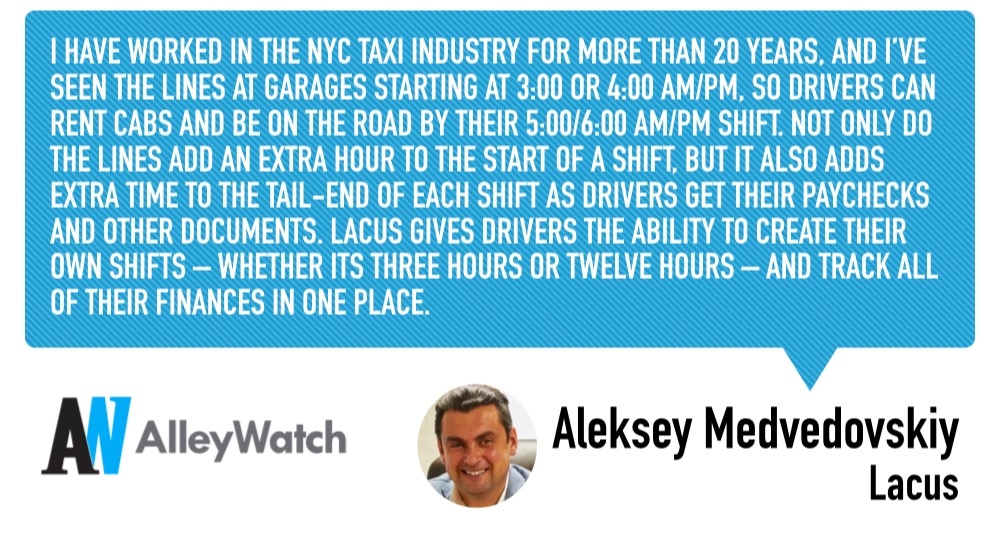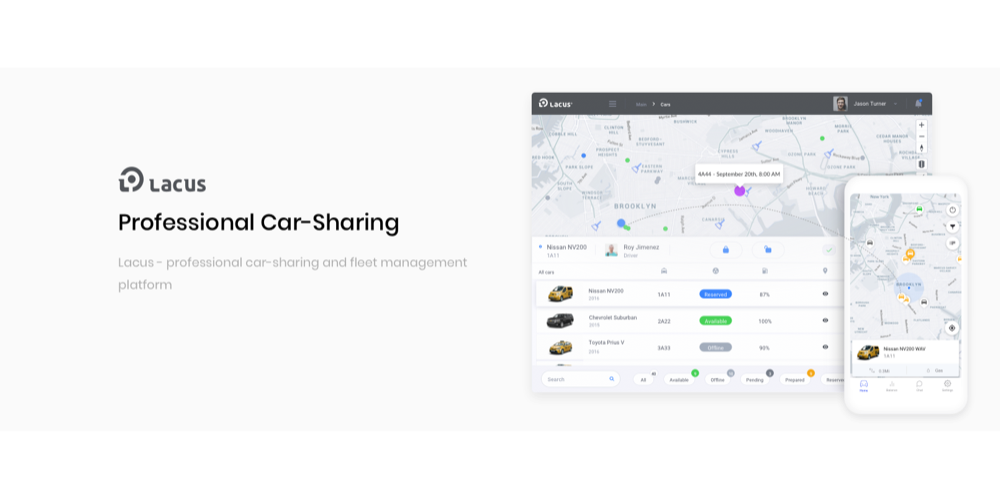There are more than 100K taxis and black cars in NYC, but despite this huge number, professional drivers have to wait up to an hour before they can get out on the road and to begin their shifts. But technological platform Lacus fixes this through its mobile app that gives drivers access to nearby taxis within the network, which eliminates the need for drivers to travel to taxi depots and wait on hour-long lines. Drivers can even allocate all their driving activity – including full expense reports and deposit and withdrawal of funds – on Lacus’s platform.
AlleyWatch spoke to founder Aleksey Medvedovskiy to learn how his firsthand experience in the NYC taxi industry inspired him to create this platform.
Tell us about the product or service that Lacus offers.
Lacus is a technology platform and mobile application built especially for professional drivers and fleet owners that provides drivers with flexibility in when they work and where they pick up their cars.
Lacus gives taxi drivers access to nearby taxis within the network, eliminating the need for drivers to travel to taxi depots, so they can sign out those cars and go. Through the app, they also have all of their data at their fingertips including detailed transactions, tollway history, accurate trip reports, full expense reports including parking, speeding or bus lane violations, and compliance with city and state rules and regulations. They can also deposit or withdraw funds directly through the platform since all financial transactions happen in one place through Lacus.
Fleet owners can manage, dispatch, maintain and automate their fleet with one system through Lacus Enterprise. It features live financial data, automatic invoicing and payment systems, remote controls and diagnostics for each vehicle, a smart event scheduling system, and more. It includes a set of features crucial for any fleet operation.
Lacus is the only platform of its kind to streamline and create efficiencies for drivers and fleet owners. It has the technology to change the way that drivers work and structure their shifts and how fleet owners rent out their cars to drivers.
What market does Lacus target and how big is it?
Drivers and fleet owners in New York City are the current target market for Lacus, and New York has more than 100K taxis and black cars making it one of the most robust markets worldwide. Currently, Lacus operates in New York City. We’re first looking to expand into all major taxi and black car markets in the United States and then expand globally. Lacus also covers all commercial vehicle/truck rentals on demand, so it is a one-stop-shop for all drivers who drive for a living.
What is the business model?
The business model is a fleet subscription, and for now, the platform is totally free for drivers.
What inspired the start of Lacus?
I have worked in the NYC taxi industry for more than 20 years, and I’ve seen the lines at garages starting at 3:00 or 4:00 AM/PM, so drivers can rent cabs and be on the road by their 5:00/6:00 AM/PM shift. Not only do the lines add an extra hour to the start of a shift, but it also adds extra time to the tail-end of each shift as drivers get their paychecks and other documents. Lacus gives drivers the ability to create their own shifts – whether its three hours or twelve hours – and track all of their finances in one place.
Through Lacus, drivers don’t need to travel to garages to find the cabs. For example, a driver who lives in Queens could also find a cab parked nearby, while a driver in Brooklyn can do the same. As ridesharing services like Uber and Lyft create increased competition for traditional taxi drivers, Lacus gives TLC drivers the flexibility benefits of rideshare services, while maintaining taxi drivers’ higher average wages.
What impact has ridesharing had on the adoption of technology by the taxi industry?
Ridesharing apps have brought increased competition to the taxi industry, but also provide new opportunities for innovation. Drivers and fleet owners are seeing the advantages of modern systems, which they can use to manage hours and expenses. This has paved the way for platforms like Lacus and other innovations we will be rolling out in the future.
Ridesharing apps have brought increased competition to the taxi industry, but also provide new opportunities for innovation. Drivers and fleet owners are seeing the advantages of modern systems, which they can use to manage hours and expenses. This has paved the way for platforms like Lacus and other innovations we will be rolling out in the future.
Lacus currently is taking advantage of ridesharing infrastructure and integrated major players in its car-sharing app.
What are the milestones that you plan to achieve within six months?
Within the next six months, we plan to subscribe as many fleets and vehicle owners as possible and improve technology from both the user and technological standpoints.
What is the one piece of startup advice that you never got?
I never received advice on market penetration or consumer education.
If you could be put in touch with anyone in the New York community who would it be and why?
If I could be put in touch with anyone in the New York community, I would like to be connected to car-sharing and ride-sharing industry leaders so we can be beneficial to each other.
Why did you launch in New York?
My parents emigrated to NY which became my hometown at the age of 12, and I have been involved with the taxi industry here for more than 20 years. New York has the most robust market for taxi drivers, so this seemed like a natural place to start Lacus before we expand to other large cities around the United States and around the globe.
What’s your favorite restaurant in the city?
My favorite restaurant in the city is Katz’s Delicatessen on East Houston Street.







